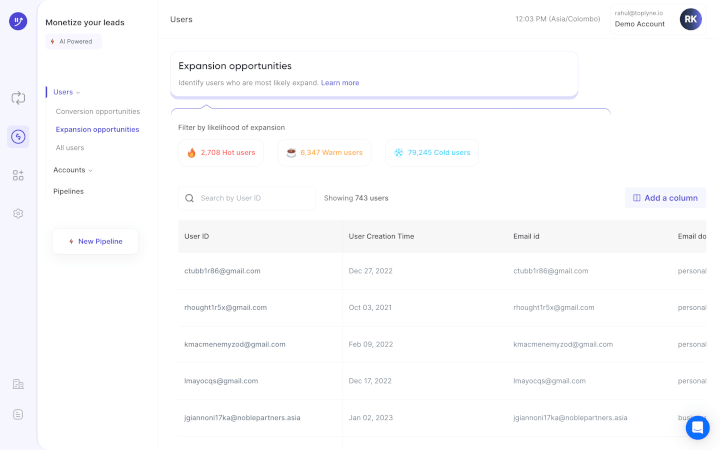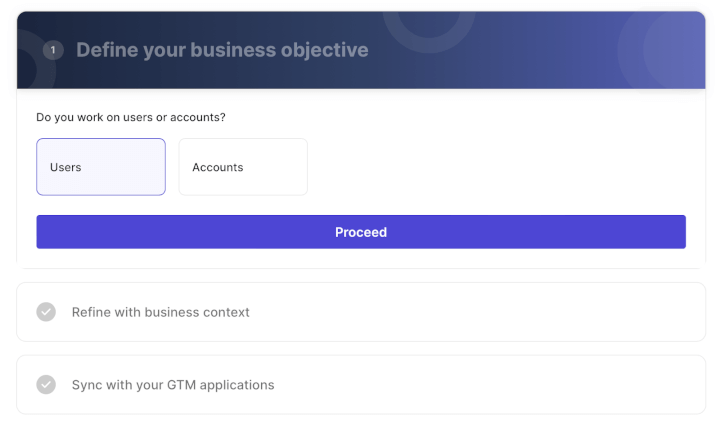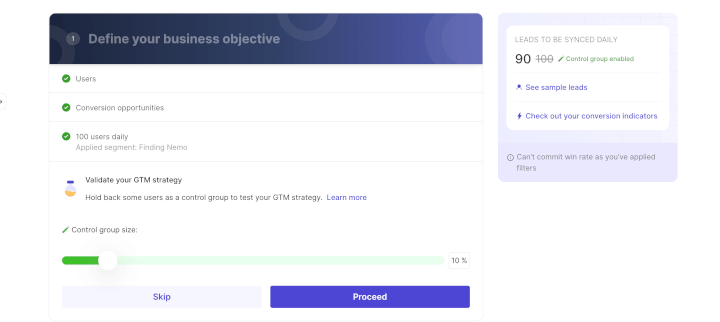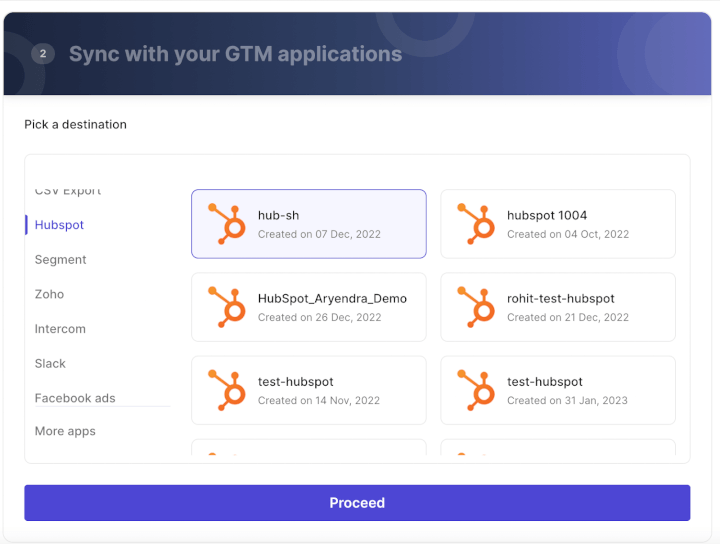How To Scale Your Earnings With Product-Led Revenue

So, you’ve heard that product-led revenue can skyrocket your SaaS platform’s earnings.
Well, you’ve heard right. 😁
Product-led revenue is closely tied to product led growth, which focuses on giving users the best customer experience possible.
And by making your users happy, your revenue will go through the roof. 🛫

We’ll show you what product-led revenue is, who drives a product-led revenue strategy and how product-led revenue can help you weather recessionary times.
We’ll also cover how product led growth (PLG) can boost your expansion revenue — and introduce a fantastic tool that helps your company turn free users into paying customers! 🥳
Ready to raise the roof?
Let’s go!
What is Product-Led Revenue?
Product-led revenue is a core facet of PLG — a business model relying heavily on the product for revenue growth.
Not familiar with PLG?
We’ve got you covered! Check out our Ultimate Guide to Product-Led Growth. 😁
With a product led growth model, your product is at the core of ✨everything✨.
Everyone in a PLG company (not just the product development team) comes together to build a product that provides immense value for its users.
What’s in it for your SaaS company?
With a product led strategy, your users become your primary source of growth — they become your biggest promoters. 🤩
And when users start deriving value from your product, that’s where product led revenue kicks in!
Your team can leverage user data to understand how people use your product.
Once they know how users behave on your platform, they can turn that knowledge into upselling and cross-selling opportunities throughout the customer journey. (More on this later!)
A product led strategy unlocks new revenue streams and expansion opportunities for your SaaS company. 🤑

Okay, but is product led revenue the only approach you can take? 🤔
Not exactly.
Product-Led vs. Revenue-Driven: Where Do They Differ?
Product-led and revenue-driven are two distinct go-to-market strategies.
Here’s the thing.
Both revenue-driven and product led companies want to build products that provide excellent value to users — and make a ton of money while doing so. 💰
The difference?
It’s how they make their decisions.
In a product led company, everything revolves around the product. Regardless of their function, all teams want to build a great product. 🌟
Additionally, in a product led organization, the product is the main player in the customer journey. It’s the primary source of customer acquisition, adoption, and customer retention.
Good examples of a product led strategy include in-app nudges, self-service, and using product usage data to deliver hyper-personalized content.
The product led model relies on the efforts of every functional team in the company, not just the product team.

Psst…
Get crucial product usage data with Toplyne’s product analytics integrations. 😌
On the other hand, revenue-driven businesses follow a sales led growth strategy with a significant marketing and sales budget.
They invest heavily in funnel-stuffing activities like running ad campaigns and sales outreach. In other words, they look for growth in non-product sources to maximize revenue. 🤝.
Teams of a sales led company can even have separate goals that help maximize their product’s income. 💲
Now that we’ve covered how the product led model differs from revenue-driven strategies let’s look at who manages the product led revenue strategy. 🤓
Who Drives a Product-Led Revenue Strategy?
We know what you’re thinking, but it isn’t the product development team.
There’s no single person or team that’s responsible for driving a product led revenue growth strategy.
Why?
Product-led growth is a strategy that requires every team — from the product team and customer service to sales and marketing. 🎨🔧
All departments of a product led organization need to collaborate to create a great product. 🤝
Here’s how the product led model works:
Sales
- The product led sales team takes on an advisory role to boost enterprise sales
- Salespeople help enterprises figure out how the product can increase revenue for them.
- The product led sales team also upsells and cross-sells to the right users.
Marketing
- Marketing teams focus on current users as a channel to boost the product’s virality and adoption rates.
- Marketing teams also collaborate with customer success teams to provide helpful resources so users can derive the best value from the product.
Product Team (Engineering and Design)
- The product development team focuses on making the on-platform user experience as seamless as possible. ✨
A smooth, flawless product experience makes users happy — and happy users always upgrade.
And that’s not it.
They’re gonna bring their friends too! 🥳

Bringing your cross-functional teams to work together is an impressive feat. It can even shorten your sales cycle — but those aren’t the only advantages of a product led revenue approach.
Let’s look at how product led revenue can help you stay afloat during stormy times. ⛈️
How Product-Led Revenue Protects You from Tough Market Cycles
Bullish business cycles and high product growth stats don’t last forever. ☹️
And when recessionary periods hit, companies lose access to capital.
It gets worse:
When there isn’t enough cash to keep everything running — the sales and marketing budget is the first to get the ax. 🪓
This means fewer sales reps and no cash for product growth strategies.
And if your product relies heavily on the marketing and sales team to bring in money— you’re going to see massive drops in revenue. 😭

Unfortunately, yes.
But there’s a solution:
Product led revenue depends significantly on word-of-mouth marketing and product virality.
See where this is going? 😏
Yep, marketing budget cuts aren’t gonna throw a spanner in your product growth strategy!
And that’s not all.
A product led growth strategy can even lower your customer acquisition cost (CAC) and give your product led company a cash buffer during tough times.
How?
Since a PLG approach always includes a free trial or freemium tier of the product, users get to explore your platform and experience its value before they make a purchase.
This way, users can determine the suitability of your product for their needs and make an informed purchase decision. Plus, a free product attracts more users, which leads to more conversions and a reduced sales cycle.
In short:
More free users = More paid subscribers eventually + Minimal customer acquisition cost 😎
Product-led revenue also helps every sales rep save time and money.
Here’s how:
Your product led company can leverage user behavior data to identify Product Qualified Leads (PQLs).
PQLs are high-intent users who have first-hand experience with your product. They also have a shorter sales cycle than other users.
When a sales rep only approaches PQLs, their chances of successfully converting are insanely high!
And if your product led growth company uses a tool like Toplyne, the sales rep will have all the data they need to discover PQLs instantly. 🤓
With all this data at their fingertips, your sales team will never chase down a bad lead again. 🥳
All these benefits can save your product led growth company a lot of money.
And when you pair it up with expansion revenue from your product led sales strategy, you won’t have to worry about lousy business cycles anymore! 📈
Okay, hold up.
What in the world is expansion revenue, and what does it have to do with PLG? 🤔
Let’s find out.
How Does Product-Led Growth Increase Expansion Revenue?
Money your product generates from any existing customer through upselling and cross-selling is considered expansion revenue. 💸
Upselling is getting an existing customer to upgrade to the next tier, while cross-selling is introducing other company-owned products to an existing customer.
Expansion revenue is essential for any product led organization not just because it boosts profit margins — but because it’s a product led growth metric indicating that customers are satisfied with your offering.
Here’s how becoming a product led growth company can boost your expansion revenue:
1. By Improving the User Experience
User experience is the heart of the growth strategy of product led companies. 💓
The more time you spend improving your product’s user experience, the more users you can upsell and cross-sell to.
How?
Well, what happens when your users are happy with your product experience? 😉
They…

And it doesn’t stop there!
A fantastic customer experience boosts adoption rates too.
When your existing users are happy with your offering, they might share their product experience with others (via online reviews and word-of-mouth). This paves the way to even more upsells and cross-sells down the road. 🛣️
2. By Enhancing Customer Success
We can’t emphasize this enough:
A successful PLG strategy requires every team to collaborate. 🤞
A PLG strategy encourages your customer success team to take a more proactive approach. And when the whole team is working on improving the product — it’s easy to identify potential friction points before they become problems.
This leaves more room for your customer success team — not just to field complaints but to enrich the customer journey by providing helpful content and proactively asking for customer feedback. 💭
When you offer excellent service, your customers reach their goals faster.
And when you help customers achieve their objectives, they’re more likely to upgrade and scale with your product. 📈

4. By Boosting Customer Retention
PLG can also help your SaaS company boost customer retention rates.
Here’s how:
A product led growth model reduces customer churn — not just by helping you build a great product but also by helping you leverage user data to spot churn risks.
Customer retention is essential for any company — especially SaaS companies with a recurring revenue model.
So when you spot a churn risk, you can act quickly and steer these users towards a better customer experience. 🧭 You can re-engage these users via the platform to increase customer retention rates. 🤝
The result?
Your customers:

Not sure what re-engagement strategies to use?
Let Toplyne do the thinking for you!
Toplyne can tell you how to reach out to various user personas — even disengaged users who wanna say: baby bye bye bye! 😉
The bonus?
The longer you retain customers, the more you can learn from their app usage data. This way, you can understand how they derive the most value from your product — and monetize it. 🤑
4. By Letting Data Drive The Way
Do you know what the backbone of a great PLG strategy is?
Data.
Lots and lots of juicy product usage data!
Access to user behavior data means revenue growth strategies are based on actual user activity instead of predictions.

For instance, if your current free users take longer to upgrade to paid plans — you can analyze how their usage compares to previous free users. 🧑💻
This way, you can quickly identify friction points preventing new users from upgrading. Next, you can engage these users with emails and in-product nudges to show them the perks of upgrading!
User data can also give you access to key metrics to track product performance. Expansion revenue is one such important product led growth metric.
Here are a few other vital metrics you need to look out for:
Natural Rate of Growth (NRG) 📈
- A strong indicator of future revenue growth and identifies whether the company can grow efficiently through the product itself.
Average Revenue Per User (ARPU) 💲
- The average income you can expect to get from each customer. You can boost ARPU via upselling and cross-selling.
Customer Lifetime Value (CLV) 💹
- Predicts how much you’ll earn from a customer throughout the business relationship.
Time-to-Value (TTV) ⏳
- This product led growth metric measures the time it takes new users to reach their first “Aha!” moment. When users activate quickly, there’s a good chance they’ll stick with your product.
Free-to-Paid Conversion Rate ⤴️
- This is the percentage of users that upgrade from a free trial or freemium tier to a paid plan.
Great, now you know the role user data plays in revenue growth.
But where do you even start to collect, organize and interpret all this data? 😵💫
That’s where Toplyne comes in!
Toplyne is a powerful tool that analyzes tons of product usage data and helps product led organizations turn free users into paying customers.💲
Here’s how companies like Canva and Vercel generate sales pipeline from their self-serve funnel using Toplyne:
- Step 1/7: Create monetization playbooks to surface conversion and expansion opportunities (leads most likely to convert to paying customers, and teams most likely to grow into larger teams)

- Step 2/7: Choose the right leads to target – users (individual users) or accounts (a group of users with an organization).

- Step 3/7: Select the frequency at which you would want leads synced in your GTM apps.

- Step 4/7: Define how many leads you want by either the number of leads or your expected win rate, depending on your sales capacity and GTM strategy.

- Step 5/7: Build custom segments - Build custom segments based on And/Or logic at the deepest level of sub-properties within your product analytics.

- Step 6/7: Validate your GTM strategy - Hold back some users as a control group to test your GTM strategy.

- Step 7/7: Sync your product qualified pipeline into your GTM destinations - CRMs, sales & marketing execution tools, and customer engagement platforms.

With Toplyne, your product will drive in so much revenue you’re not gonna know what to do with all that moolah. 🤑
Fair warning.
Once you implement Toplyne, your platform might have trouble processing the stampede of upgrades that come in. 🥵

Skyrocket Your Product-Led Revenue with Toplyne!
If you’ve been looking to shift your SaaS product to a product led growth model, there’s never been a better time. ⏳
Product-led growth helps you:
- Grow your user base
- Boost conversion rates
- Retain customers
- Make it rain! 💰
But most importantly, a PLG strategy ensures your users are always happy with your product — and that they always get what they pay for and more! 🤩
Use a tool like Toplyne, and you’ll get all the data you need to successfully implement a product-led revenue strategy.
So, what are you waiting for?
Sign up for Toplyne today and watch your revenue go 🚀



.svg)









.png)